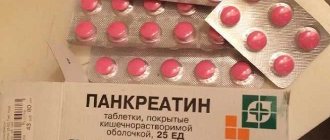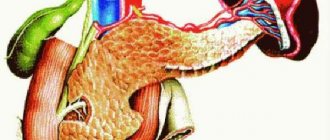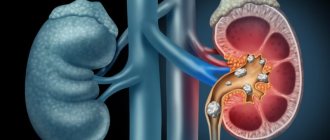Etiology
The pancreas consists of parts such as the head, body and tail.
The entire organ or one of its parts can become enlarged. In each case, the sources of the pathological process will be different. The pancreas becomes completely enlarged in adults and children in the vast majority of cases due to an acute inflammatory process in this organ. However, this condition can also be caused by:
- the formation of stones that lead to blockage of the duct;
- cystic fibrosis is a hereditary disease, the causes of which remain unknown;
- alcohol abuse;
- a wide range of traumas and wounds of the abdominal cavity;
- the course of an infectious disease, for example, influenza or hepatitis, intestinal infections, mumps or sepsis;
- uncontrolled use of certain groups of medications, in particular hormonal substances;
- excessive physical activity;
- increased calcium levels in the blood;
- anomalies of the development of the pancreas, in particular, a ring or horseshoe shape, as well as the presence of bends and constrictions;
- bile duct dyskinesia;
- the presence of autoimmune processes in a person, in which the body produces antibodies against its own healthy cells and tissues;
- inflammation of the duodenum, spreading to the major papilla, into which the pancreatic duct opens;
- severe food poisoning;
- ulcerative lesions of the duodenum or stomach;
- disturbance of local blood supply - often formed against the background of vascular atherosclerosis, compression by a neoplasm or accidental dressing during medical intervention.
Causes of pancreas enlargement
However, not in all cases, the course of pancreatitis leads to changes in the volume of the entire organ. It is not uncommon for a situation in which the pathological process is active in the head, body or tail of the pancreas. But during diagnostic measures, other diseases can be identified that lead to deviations from the norm in the size of one or another structural part of the pancreas.
Thus, the enlargement of the tail of the pancreas is due to:
- the formation of pseudocysts, which are a consequence of pancreatitis;
- the formation of abscesses filled with purulent fluid;
- benign tumor developing from glandular tissue;
- an oncological process in which neoplasms are large and compress the tail of this organ;
- a stone, the localization of which is the Wirsung duct, located in the area of the body of the gland.
Enlargement of the head of the pancreas occurs due to:
- the presence of a pseudocyst or abscess in this structural zone;
- metastasis of a cancer tumor from nearby internal organs or its own malignancy;
- presence of cystic adenoma;
- duodenitis, leading to inflammation of the minor papilla of the duodenum, into which an additional duct opens, located in the head of the pancreas;
- scarring or the appearance of a tumor in the minor papilla of the duodenum;
- the appearance of stones.
All of the above etiological factors lead to the fact that during instrumental diagnostics a condition will be identified in which the pancreas is enlarged in a child or an adult.
The main risk groups are:
- people who have been drinking alcohol or smoking cigarettes for many years;
- babies during teething;
- adolescents of adolescence;
- infants who are transferred from breastfeeding to artificial nutrition;
- persons whose menu is dominated by fatty, salty and spicy foods. It is for this reason that diet is an important part of therapy.
Main reasons
If the pancreas is enlarged, then the cause may be hidden in congenital defects, which are caused by inflammation, internal infection of the body, or malfunction of the entire endocrine system.
When it is impossible to work normally and cope with basic tasks, the iron begins to increase in order to compensate for the condition.
The causes and symptoms are different for each person, therefore the growth of the part can have different types of manifestation.
Total increase
Enlargement of the pancreas in all zones at once often appears as a result of acute pancreatitis or during exacerbation of the chronic phase of the disease.
With pathology, the inflammatory process can spread to other internal organs, including the kidneys, liver and others.
In addition to pancreatitis, the growth of all parts at the same time can be caused by other reasons:
- Genetic predisposition.
- Congenital pathologies, if the gland has an irregular structure and shape.
- Cystic fibrosis, which is often diagnosed in childhood.
- Inflammatory process in the gland of various types.
- Infectious diseases, from simple flu to hepatitis or sepsis.
- Poisoning with chemicals, alcohol or medications. In this case, additional growth of the liver begins.
- Damage to the abdominal cavity and tissues of the gland itself.
- Ulcerative diseases in the intestines.
- Autoimmune processes.
Local increase
With local damage, the growth of one of the parts of the organ begins. Typically, the tail and head of the pancreas are the most enlarged.
The main reason is pancreatitis, if the inflammation occurs in one area.
The head is in close proximity to the duodenum, due to which intestinal pathologies can cause disturbances in the functioning of the gland.
Among the main reasons for tail enlargement are:
- A pseudocyst that develops against the background of acute pancreatitis.
- Purulent accumulation in the capsule.
- The formation of a benign tumor or the presence of large malignant neoplasms.
- Stones in the ducts of the gland, which lead to blockage.
- Pseudocyst.
- Abscess.
- Adenoma.
- Inflammation of the duodenum, which affects the papilla.
- Scars and tumors in the intestines.
Among the characteristic reasons why the head of the pancreas is enlarged are:
- Pseudocyst.
- Abscess.
- Cancerous tumors.
- Duodenitis.
- Tumor in the intestine.
- Presence of stones in the ducts.
You can suspect something is wrong not only at a doctor’s appointment; every person is able to independently understand that pathological processes have begun in the body.
The main thing is to know the main signs of violations.
What is the pancreas needed for?
The body of a small child is most susceptible to various diseases. The child’s immunity gains strength gradually, as his organs, muscles, etc. develop. But sometimes the body begins to malfunction.
Inflammation of the pancreas in a child occurs with pain in the abdominal area. In acute illness, body temperature may rise.
If painful attacks are repeated very often, this means that the disease has become chronic.
Symptoms of the acute stage of inflammation of the pancreas are vomiting and nausea, severe pain under the ribs, pale skin, fever, sweating and weakness. At first the child will feel normal, and after that the first signs of an enlarged pancreas will appear. These may include slight dizziness, headache and changes in personality. Impaired outflow of bile from the gallbladder in children is associated with the danger of stagnation of peptides and gastric juice.
The pancreas is one of the vital organs in the human body. It is elongated and located in the abdominal cavity behind the stomach. The head, tail and body of the organ, which inside is a duct, are distinguished.
Iron is necessary for the production of digestive enzymes (enzymes), which then enter the gastrointestinal tract. This organ is also an endocrine gland and performs an endocrine function. The insulin and enzymes it produces are involved in the breakdown of food.
If the tail of the pancreas, its body and head are enlarged, this most often indicates non-compliance with nutritional rules and the occurrence of inflammation. Normally, the head of the organ should be 18-26 mm, the tail - 16-20 mm (this depends on the age of the person). Due to inflammatory processes, iron increases, which can lead to a dangerous disease - pancreatitis. With this disease, the outflow of digestive juice and enzymes produced by the pancreas into the small intestine is disrupted.
Reasons for organ enlargement
Changes in proportions can affect the pancreas as a whole (total increase) or its individual parts (local). There can be many destructive processes that cause this condition. The main reasons for an increase in the pancreas: compensation for the lack of its function, swelling that accompanies general or local inflammation of the organ.
Sources of organ enlargement can be:
- unhealthy diet (abuse of fatty foods, sweets, preservatives);
- cystic fibrosis;
- alcohol abuse;
- gallstones;
- abdominal injuries;
- infectious processes (flu, hepatitis);
- drug abuse;
- hypercalcemia;
- stomach ulcer;
- tumor formations.
Local enlargement of individual parts of the gland occurs when compactions form in their tissues. This can also occur when inflammation in a particular segment of the organ increases.
Find out the instructions for using the drug Mastopol for the treatment of fibrocystic mastopathy.
How to properly massage the mammary glands during lactostasis in nursing mothers is written on this page.
Enlargement of the head and tail of the pancreas may be associated with:
- blockage of ducts with stones;
- cyst, adenoma;
- purulent processes, abscess;
- pseudocysts that form at the end of acute pancreatitis;
- malignant tumor.
Enlarged pancreas in children
The child's body is more susceptible to adverse factors than adults, due to its incomplete formation.
READ ALSO: How and with what to treat the pancreas during an exacerbation: medications, nutrition and lifestyle correction
The main reasons that lead to changes in the pancreas in children are often:
- poor nutrition, high content of fast carbohydrates and fatty foods in the diet;
- food poisoning;
- lack of physical activity or excessive exercise;
- frequent viral and bacterial infections;
- abuse of antibiotics and other potent drugs;
Dangerous periods during which the pancreas is more likely to be disrupted:
- lure;
- teething;
- admission to kindergarten, school;
- adolescence.
Symptoms of the disease
It is impossible to immediately determine that the organ has changed in size, since it is located inside the abdominal cavity. It will be possible to detect an enlargement of the head of the pancreas only by performing ultrasound diagnostics or magnetic resonance imaging.
The development of symptoms of the disease manifests itself depending on the individual characteristics of the body. It is possible that the pancreas will not make itself known for years, although inflammatory processes are already underway. And the pain can be of different strength in different people. The following factors indicate a problem in the organ:
- significant increase in temperature;
- diarrhea, nausea and vomiting;
- lack of appetite, presence of bitterness in the mouth;
- pain of varying intensity in the abdomen (in the upper part), radiating to the lumbar spine or arm.
Why is this pathology dangerous? If the head of the pancreas is enlarged, it can cause obstruction of the duodenum, as it puts pressure on it. The disease can lead to impaired liver function, as indicated by the appearance of vomiting, diarrhea, bitterness and belching. A sign of pathology may also be an expansion of the Wirsung duct (the main one in the gland). The causes of the condition are the same as for other organ lesions.
An enlarged pancreas in an adult and a child requires urgent action - you need to consult a specialist. Before a medical examination, you should refrain from drinking alcohol, do not heat your stomach, and stop eating spicy, fried, smoked and fatty foods.
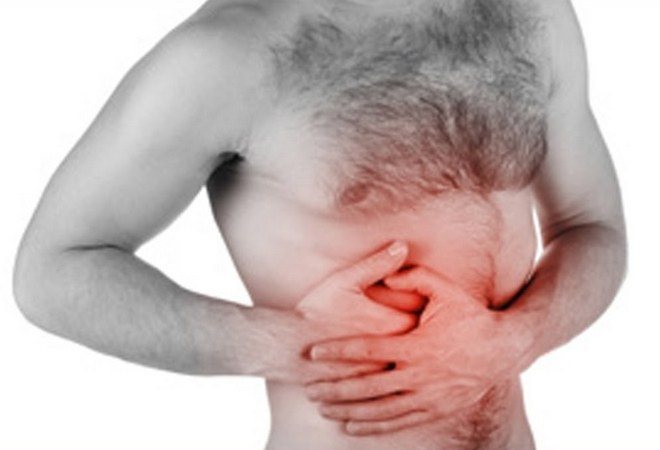
Enlargement of the tail of the pancreas (or head) can also be diagnosed in a child. Symptoms of damage:
- Painful sensations in the upper abdomen.
- Fever (during the acute period).
Increased pain in the abdominal area is observed in the chronic form of the disease.
The disease also affects infants. Causes of the condition:
- low body resistance to microbes;
- weak immunity;
- insufficient and unbalanced nutrition;
- lack of physical activity;
- non-compliance with sanitary and hygienic standards of maintenance.
All this negatively affects not only the health, but also the overall development of the baby.
Sometimes ultrasound shows diffuse (or uniform) changes in the organ. This pathology of the gland has the following causes:
- food poisoning;
- getting injured;
- excessive physical activity;
- excessive pill intake;
- hereditary diseases;
- eating fatty and fried foods;
- non-compliance with diet.
Such changes are a cause for concern for parents, because inflammation of the pancreas can lead to liver disease, which, together with the organ in question, is important for human life.
Signs of increase
Unfortunately, changes in the functioning of internal organs cannot always be felt - some diseases develop without symptoms. And inflammation of the head of the pancreas in most cases is asymptomatic, while in others the whole complex of the following symptoms appears.
Symptoms may vary depending on age and physical condition:
- pain of varying strength, radiating either to the left arm or to the lower back;
- burning in the upper abdomen, in the divergence of the ribs;
- increased body temperature, which is difficult to bring down;
- frequent attacks of nausea leading to vomiting;
- instability of bowel movements: diarrhea alternates with constipation.
How does the head of the pancreas hurt? If you are bothered by severe pain in the upper abdomen, radiating to other parts of the body, sometimes reminiscent of strong pulsation, this is a problem with the head of the gland. If, in addition to pain, you have a fever and nausea, you must immediately go to the hospital for examination.
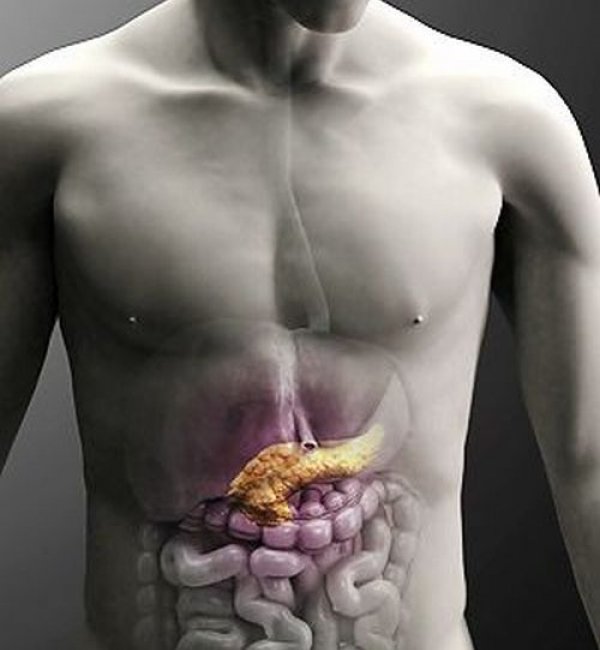
Occasionally, the patient may only be bothered by attacks of pain in the head of the pancreas, for which the therapist prescribes ultrasound diagnostics. Based on the results, the doctor sends the patient to a gastroenterologist for a more detailed examination, diagnosis and selection of subsequent treatment.
Information! If the head of the pancreas hurts, you should urgently make an appointment with a doctor for an examination. In addition to discomfort, pain in the body indicates pathologies, and they require professional treatment.
Symptoms
Enlargement of the pancreas in a child and an adult occurs individually. In some cases, the pathology may not show any symptoms for quite a long time. In such situations, the disorder is diagnosed completely by accident during instrumental examinations to identify a completely different disease or for preventive purposes.
Most often, this organ enlarges due to an inflammatory process occurring in it, which is why the disease has pronounced symptoms. The very first clinical manifestation is pain, which can be acute or aching. The location of the pain is the upper abdomen. Often the pain radiates to the lower back or left arm.
If the head of the pancreas is enlarged, then the main symptoms, in addition to pain, are considered to be stool upset, which is expressed in the form of diarrhea. The severity of such manifestations is determined by the proximity of the affected organ to the duodenum.

Symptoms of an enlarged pancreas
The pancreas and liver are two interconnected organs, which is why when one becomes ill, the other suffers. With this disorder, signs of liver damage can be considered:
- attacks of nausea, which almost always end in vomiting;
- bitter belching;
- the appearance of a bitter taste in the mouth;
- profuse diarrhea;
- decreased appetite;
- change in the shade of the skin and mucous membranes. Often the jaundice is mild in nature.
Clinical signs that a child’s pancreas is enlarged will be somewhat different:
- constant nausea, but vomiting is rare;
- increased sweating;
- pale skin;
- heaviness and discomfort in the stomach;
- feeling of pain behind the ribs;
- weakness and increased fatigue;
- intense headache and dizziness;
- significant increase in temperature;
- complete lack of appetite.
In children who cannot yet speak, the main symptoms of this pathology will be:
- severe crying;
- unnatural posture of the child - children tuck their legs towards their stomach;
- heat;
- profuse vomiting.
In cases where one or more of the above signs appear in an adult or child, you should seek qualified help as soon as possible, because there is a possibility of damage not only to the pancreas, but also to internal organs such as the spleen and liver.
Symptoms of enlargement
Very often the pathology does not manifest itself for a long time. But there are times when even a small deviation from normal parameters quickly makes itself felt.
If a person has at least one symptom indicating a change in the size of the pancreas, one should immediately consult a doctor.
The doctor prescribes specific studies that will accurately determine the condition of the gland.
You can suspect the presence of a pathology in the functioning of an organ by the presence of the following characteristic signs:
- There is pain in the upper abdomen. The intensity of pain may increase or decrease. Most often, patients who have dilated pancreas describe discomfort and pain, like a slight burning sensation in the abdominal cavity. In addition, some patients say that pain with an enlarged gland manifests itself in severe attacks. Pain that occurs in the peritoneal area can migrate to the left arm and to the lumbar region.
- Discomfort that appears in the stomach area may accompany an increase in body temperature to a level of 38-39 degrees. Most often, an increase in temperature is associated with the development of an inflammatory process in the tissues of the organ.
- The patient develops a feeling of nausea, which can be aggravated by vomiting and digestive disorders, manifested by diarrhea. When a malfunction occurs, a bitter taste is felt in the oral cavity.
Types of changes
To create an effective treatment plan, the doctor will need information about the size of the gland, the exact location of the enlarged areas, and the nature of the structural changes found in the parenchymal tissues. The main criterion for classification is the localization of edematous areas of the parenchyma.
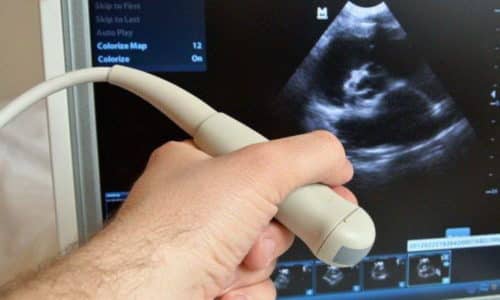
To create an effective treatment plan, the doctor will need information about the size of the gland, the exact location of the enlarged areas, and the nature of the structural changes found in the parenchymal tissues. This data is obtained using ultrasound.
Total
Total enlargement is considered to be those cases when the gland is changed evenly and proportionally, has a mass of more than 80 g, a length of 22 cm and a width of 3 cm (norms for mature patients).
If a total type of gland enlargement is detected, other organs of the gastrointestinal tract are additionally examined, since with this type of disorder the spleen, duodenum and liver are often modified. Disorders in these organs are due to the fact that the evenly enlarged gland does not function correctly, secreting too viscous secretion.
Local
With a local type of enlargement, a compaction or inflamed area forms in the head, body or tail of an organ while the structure, shape and size of its remaining parts remain unchanged.
Local changes most often occur in the tail or head, and in the latter case the duodenum becomes inflamed at the same time. Acute or chronic pancreatitis often leads to expansion of the structural parts of the organ.
Diffuse
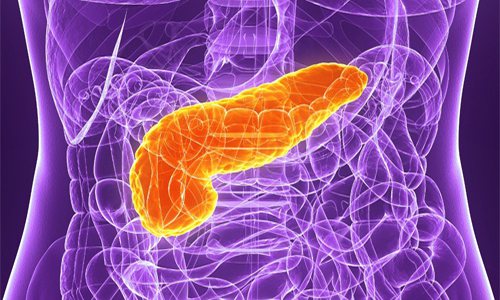
In determining the disease that caused pathological changes in a parenchymal organ, not only the volume of glandular tissues is considered, but also their density. Normally, the pancreas has a homogeneous structure. If there are areas within an organ with different densities (inflamed or subjected to fatty degeneration), petrification and calcifications, doctors indicate diffuse changes in the organ.
Moderate
Diffuse changes in the pancreas are distinguished by severity. With a moderate diffuse increase, there are no symptoms of tissue degeneration and enzyme deficiency.
Being asymptomatic, they do not require special therapeutic measures and are corrected using conservative methods.
Jet
Due to the location of iron, it can be modified under the influence of inflammatory processes or due to insufficient functionality of nearby organs (liver, bile ducts, stomach). Reactive changes in the pancreas are eliminated during treatment of the disease that caused tissue enlargement.
Diagnostic methods and treatment
To determine the presence of an illness, you need to tell your doctor about the signs of illness. But in order for a specialist to be able to prescribe procedures and the necessary medications, it will be necessary to perform an ultrasound diagnosis of the organ and undergo an examination.
In some cases, emergency surgery may be required. Indications for it are acute inflammatory process, purulent inflammation of organ tissue.
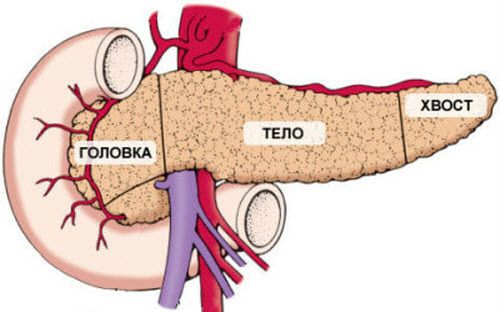
For chronic pancreatitis, it is necessary to undergo a course of treatment in a hospital and be constantly under the supervision of a doctor.
If tests show that the pancreas is enlarged, then treatment will include the following:
- diet;
- decreased activity of the digestive system;
- applying a cold compress;
- taking digestive enzyme medications.
If pain in the pancreas area does not give you peace, then you need to immediately take a number of measures. First aid: daily fasting, applying ice to the stomach (under the ribs on the left side). In case of acute pain, you can take No-shpa or Papaverine, then you should call an ambulance. Other medications should not be taken. Only a doctor should prescribe medications to treat the organ.
In what diseases does it increase?
The structure, shape and size of the pancreas change with the development of the following pathologies:
- Pancreatitis. Enlargement of the organ occurs under the influence of increased production of enzymes entering the gland itself, corroding its tissues and causing internal inflammation.
- Pancreatic necrosis. In a disease that develops as a complication of pancreatitis, purulent processes that accompany the death of the organ lead to an increase in the pancreas.
- Diabetes. When endocrine function is impaired, enzymes, instead of being activated in the duodenum, begin to act in the organ itself, which leads to an increase in its volume.
- Lipomatosis (fatty degeneration of parenchyma). An increase in the number of fat cells leads to the proliferation of glandular tissues.
- Adenoma. In 70% of cases, local enlargement of the organ occurs due to the proliferation of adenomatous tissue.
- Carcinoma. The pancreas enlarges as a result of cancer cell division.
Mandatory diet
The pancreas will not function properly without the right food. If the digestive system suffers, then diet No. 5 is most suitable, limiting the consumption of foods high in fat. Dietary nutrition will help restore organ cells.
Forbidden food:
- alcohol;
- foods high in fat (lard, butter, sour cream);
- rich broth and soups;
- fresh vegetables and fruits;
- smoked meats, fried foods;
- spices;
- sweet treats.
Will be useful:
- stewed vegetables (stew);
- porridge with water;
- stale bread;
- cottage cheese and kefir without fat;
- boiled or baked meat and low-fat fish.
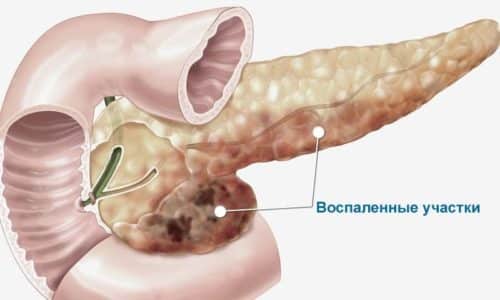
You can improve the condition of your organs and get rid of pain only with proper nutrition. Sometimes a well-chosen diet helps reduce swelling, relieve inflammation, and subsequently avoid surgery. Previously, a person could not live after removal of the gland. In the modern world, people are able to do without an organ; in this case, replacement therapy in the form of enzyme preparations, lipotropic drugs and insulin is mandatory. But it is still better to keep the organ in a healthy state.
Treatment
Only a doctor can determine what to do if such a pathology is detected. After all, the choice of treatment methods depends on what caused the change in the size of the gland. Depending on the cause of the pathology, the following methods are used:
- applying cold;
- following a special diet, and sometimes completely refusing food for several days;
- use of medications;
- surgical intervention.
In case of chronic course of the pathology, outpatient treatment is possible, but in case of acute pancreatitis or in case of abscess formation, it is necessary to urgently place the patient in a hospital.
Nutrition
Diet is the main method of treatment for any pathology of the pancreas. After all, its job is to produce enzymes for digesting food. Therefore, gentle nutrition reduces the load on this organ and prevents complications. In some cases, only one diet without the use of other methods allows the organ to return to its normal size.
The most important thing is to completely eliminate alcoholic beverages and fatty dairy products. It is prohibited to consume meat or fish broths, spicy and fried foods, raw vegetables and fruits, and freshly squeezed juices.
Basically, for all diseases of the pancreas, the Pevzner diet is prescribed. It involves increasing the proportion of protein in food and almost completely limiting fat. The diet should include lean meats and fish, low-fat dairy products, crackers or biscuits, cereals, and vegetable dishes. All foods need to be boiled, stewed or baked. It is advisable to eat food 5-6 times a day in small portions.

If the pancreas is enlarged, diet should be the main treatment method.
Medications
If the pancreas is enlarged, special medications will help bring it back to normal. Most often, proton pump inhibitors are prescribed for this, for example, Omeprazole and histamine receptor blockers. They help reduce the secretion of pancreatic juice.
In addition, enzyme preparations are needed that help digest food, relieving the load on the pancreas. Most often these are Pancreatin, Mezim-Forte, Festal. And to relieve pain and inflammation, painkillers and anti-inflammatory drugs are prescribed: No-Shpa, Ketorol, Ibuprofen or Paracetamol. Cerucal, Domperidone, Itopride are effective against nausea and vomiting.
Traditional recipes will help
Sometimes these time-tested remedies can offer significant health benefits, allowing you to abandon expensive traditional drug treatment. Healing decoctions, infusions, and juices are prepared from herbs, root vegetables, and cereals. Potato juice is an effective remedy for pancreatic diseases. They drink it 2 hours before meals, 100 g each. Take it for 2 weeks, then take a break for 2-3 months, then continue treatment again.
This decoction has also proven itself to be effective: take burdock root, crush it, then add water (0.5 l). The product is infused for 5 hours. After this, it is boiled over fire for 30 minutes. Then you need to strain the broth and drink 1 glass after meals.
Life forecast
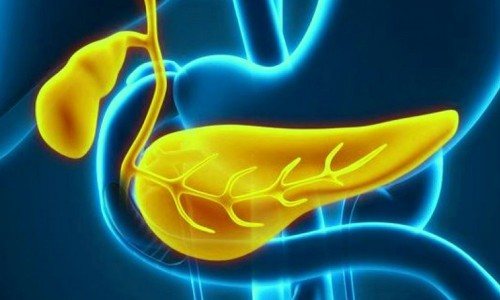
With early detection of changes in the pancreas and timely adequate treatment, the prognosis for life is favorable. After eliminating the original source of inflammation or correcting the disease that caused the compensatory enlargement of the organ, the size of the gland returns to normal and its function is completely restored.

With early detection of changes in the pancreas and timely adequate treatment, the prognosis for life is favorable.
Prognosis worsens in the case of a rapidly progressing tumor process detected at stage 4 of development. Due to the growth of the oncological tumor deep into the surrounding tissues and the rapid growth of the tumor, cancer cachexia (progressive depletion of the body), obstructive jaundice, and many other complications that lead to death develop.
Prevention of pancreatic diseases
To resist the disease, it is necessary to strengthen the immune system. It is necessary to increase resistance to viruses and bacteria that can disrupt pancreatic function. It is especially important to monitor children’s nutrition during the following periods of life:
- infancy, when complementary feeding begins;
- when transferring the baby to artificial feeding;
- during tooth growth;
- before starting school and upon entering preschool;
- during the teenage period of a child's growing up.
The most effective way of prevention is to normalize your diet and lead a healthy lifestyle. You will need to give up tobacco, since smoking introduces tars and harmful substances into the body that contribute to the exacerbation of the disease. Avoiding alcohol, the destructive effects of which are known, will help relieve the burden on the pancreas.
If treatment is not started in time, the gland will continue to enlarge, abscesses may appear, and tissue necrosis may begin. In especially severe cases, the disease can become life-threatening, turning into oncology.
An enlarged pancreas is the result of a serious pathology. In this case, you cannot decide for yourself what and how to treat. The organ must be treated by a specialist, taking into account all the individual characteristics of the patient and based on test data and examination results. Then the question will not arise about what to do if the pancreas is enlarged.
General directions of therapy
If an enlarged pancreas is detected and its causes are clarified, an individual treatment plan is selected taking into account the diagnostic results.
With the development of pancreatitis, abscess, or obstruction of the duct with stones, the patient is admitted to the hospital, where a decision is made whether surgical intervention is necessary. Conservative therapy involves taking medications to normalize the condition of the pancreas and diet.
READ ALSO: List of drugs - pancreatic enzymes and features of their use in diseases of the organ
Groups of drugs that are used for organ enlargement:
- antacids (Almagel, Phosphalugel);
- antispasmodics (No-shpa, Duspatalin);
- proton pump inhibitors (Omez, Omeprazole);
- pancreatic enzymes (Festal, Digestal);
- antiemetics (Cerucal, Itoprid);
- choleretic (Hofitol, Artichoke) and others, as prescribed by a specialist.
Learn about the first symptoms of follicular thyroid cancer and treatment for cancer.
The symptoms and treatment of adrenal diseases using traditional medicine are written on this page.
Go to https://vse-o-gormonah.com/hormones/drugie/ionizirovannyj-kaltsij.html and read about the reasons for the increase in ionized calcium in the blood and how to bring the levels back to normal.
Diet and nutritional habits
Regardless of the reasons for the enlarged pancreas, nutritional correction should become an integral part of treatment. If you have problems with the organ, it is recommended to follow diet No. 5P.
Nutrition rules:
- eat 5-6 times a day;
- portions should be small;
- reduce fat intake;
- food should be warm, crushed, and not irritate the pancreas;
- steam, bake, boil food;
- You can have lean meat, fish, low-fat dairy products, water-based porridge, low-fat broths.
Dietary nutrition allows you to reduce the load on the pancreas and restore its functionality. Compliance with the rules of the diet makes it possible to improve the overall well-being of the patient.



